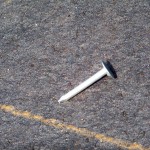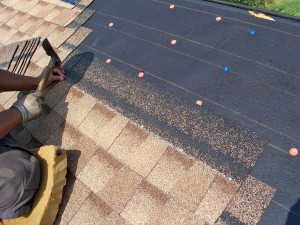The single most common problem with roofing shingle installation is improper nailing. Most shingle blow-offs are a result of a nailing issue.
Shingles are designed with a nailing strip – the optimum location for nailing that will minimize shingle loss during major wind storms. The key to preventing roof damage is the utilization of the correct nail and the proper installation of the nail.
The nail should be a standard round wire, zinc-coated steel or aluminum; 10 to 12 gauge, smooth, barbed or deformed shank, with heads 3/8 inch (9mm) to 7/16 inch (11mm) in diameter. Length must be sufficient to penetrate into solid wood at least 3/4 inch (19mm) or through plywood or oriented strand board by at least 1/8 inch (3.18mm).

The location of the nail through the shingle is determined by the shingle manufacturer. Typically there is a marked nailing strip or location for nailing. Typically four (4) nails are utilized in installing a single shingle, however many manufacturers wind warranties require six (6) nails installed along the nailing strip.
Hand nailing is the preferred method for the application of the nails. The introduction of the nail gun into the roofing industry has created poor quality installations. Under-driven nails poke through shingles lying on top of them. Over-driven nails go all the way through the shingles. Nails in the wrong location cause shingles to fall apart or blow off the roof. The improper calibration of the nail guns and the varying air compression – based on multiple nail guns, along with the varying temperatures that affect the shingle pliability, are the culprits in bad nail gun installations.
At State Roofing Company we strongly believe that the right way to install a nail is with a hammer. The only way to ensure that a nail is driven to the proper depth and in the proper location is a skilled roofing installer with a hammer. Nails must be driven flush with the shingle surface. Do not overdrive or under drive the nails.

State Roofing Company typically utilizes a galvanized 1 ¼” ring-shank roofing nail, always hand nailed and always six (6) nails per shingle. This preferred shingle installation is optimum for securing the shingles and also, quieter during the installation.